‘Daisy Jones & the Six’: Why Shooting at Actual L.A. Rock ‘n’ Roll Landmarks Was a ‘Gift to the Actors’
- Oops!Something went wrong.Please try again later.
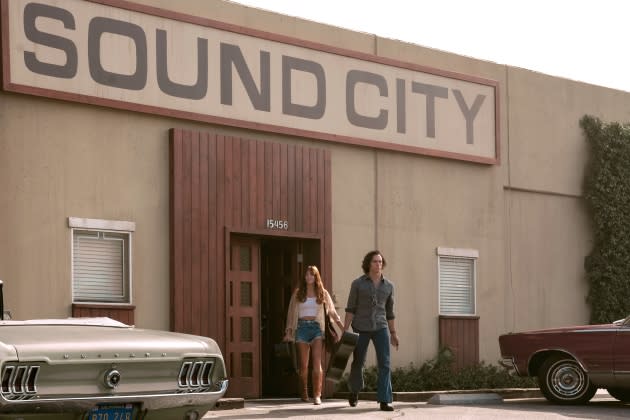
They say L.A. has no history, and yet, thankfully there are still enough vestiges of the Laurel Canyon folk-rock scene of the 1970s to fully stock a throwback series like “Daisy Jones & the Six.” Set among the flowy dresses and shaggy mustaches of the city’s rock ‘n’ roll heyday, the series gives aspiring rockers Daisy Jones and Billy Dunne, played by Riley Keough and Sam Claflin, plenty of classic places to hang out, giving the gauzy musical series a grounding in a specific time and place.
The show’s production designer, Jessica Kender, explains that in some cases, it was more important to capture the feeling of the era than to use the exact location. A perfect example is the front of the Six’s house in Laurel Canyon, which was designed to evoke the iconic cover of “Crosby, Stills & Nash” with the band sitting on a brown couch in front of a long-ago torn-down house.
More from Variety
But when the vintage locations were available, the team felt it was important to shoot there. “Being in the real places provides this intangible quality — it’s sort of a gift to the actors to be in the actual places where this beautiful music actually happened,” she says. “Our director said being in the places where this music is played will change the way our actors behave.”
Kender wanted to make sure the show looked as gritty and golden as the ’70s really were. “We stayed away from the bright, Austin Powers-like colors, and tried to stay more in the tones that were actually there, like the browns and the yellows,” Kender explains.
Here’s how Kender and her team found the perfect historic locations and made them work for the show.
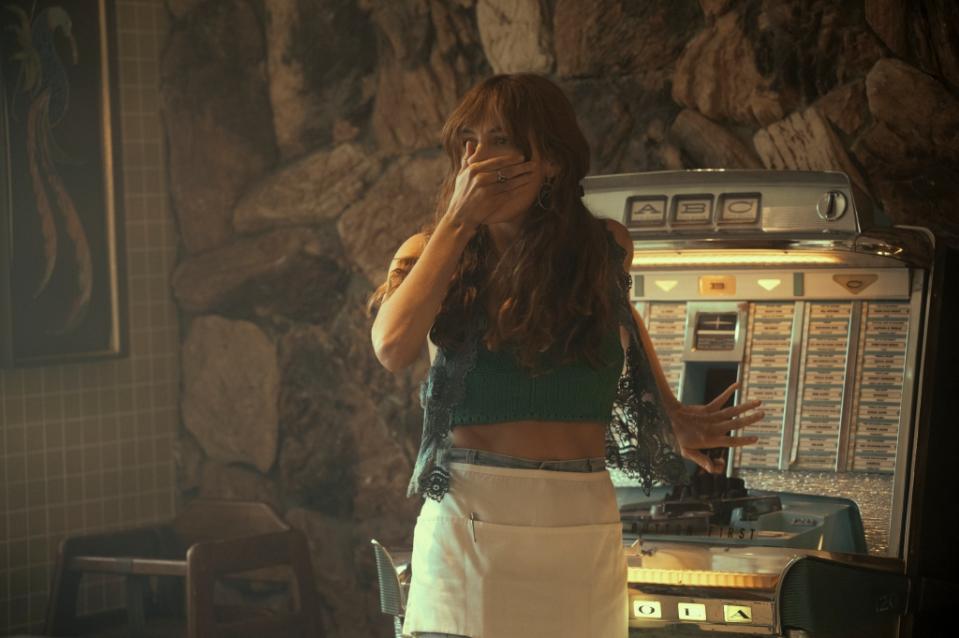
Hollywood Hills Coffee Shop/ Duke’s
The Hollywood Hills Coffee Shop quickly became a Hollywood classic after it got cleaned up with a makeover and new chef in 1994 and was then immortalized in the 1996 movie “Swingers.” Was it a popular hangout for rockers and hangers-on way back in the 1970s? Not really, though it did exist. In those days, it was far more likely to find strummers and songbirds at Duke’s Tropicana Coffee Shop or Barney’s Beanery. Since Duke’s is long gone, the series shot at the Hollywood Hills Coffee Shop.
Recently reborn as Clark Street Diner, it looks convincingly like someplace Daisy might have slung hash before hitting it big, with its flagstone wall, golden Naugahyde booths and rows of photos of famous patrons. However, a neon sign for Duke’s was added. “I felt like if we couldn’t get the actual thing, since Duke’s no longer exists, as long as we emulated the feel of the places, that was enough,” Kender says.
The Whisky a Go Go
It’s not surprising Daisy would show up at the Whisky on one of her very first forays into the L.A. music world — the rock club was basically the epicenter of the Sunset Strip scene from the mid-1960s until well into the 1970s and beyond. Jim Morrison got around to just about everywhere in Hollywood, but the Whisky is where the Doors were the house band, and one of the first places where go-go girls frugging and watusi-ing in cages above the dancefloor became popular. The Turtles, Love, the Byrds and Van Morrison’s Them were just a few of the dozens of other bands whose careers were juiced by Whisky appearances. But of course, it doesn’t look exactly the same 50 years later.
“The Whisky doesn’t have go-go cages anymore. It used to be covered in vintage wallpaper,” Kender explains. The club needed to quickly return to its live music schedule after the art department dressed it for the ’70s, so “we were given like 24 hours, we would run crews morning and night,” she says.
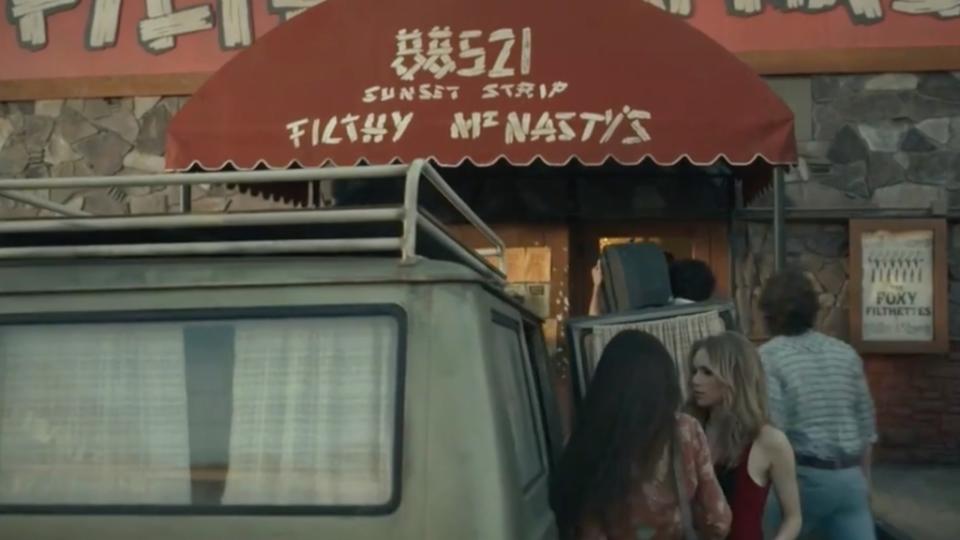
Filthy McNasty’s
Not quite in the same league as the Troubadour and Whiskey a Go Go, the smaller club Filthy McNasty’s was nonetheless a fixture of the 1970s and ’80s Sunset Strip. It’s only natural that the Six would get one of their first gigs at this lower-key spot, which was frequented by the likes of Elvis, Mick Jagger and Jim Morrison. In the early 1990s, the bar, then called The Central, was sold to a group of young Hollywood types including Johnny Depp, who renamed it the Viper Room. River Phoenix tragically overdosed on the sidewalk in front in 1993.
While there was enough documentation of the heyday of the Sunset Strip to compile a large reference binder, it was nearly impossible to find photos or film that actually showed the interior when it was still Filthy McNasty’s. The solution? “We did find a softcore porn that we used,” she reveals — complete with a catchy Filthy’s song.
“We knew we wanted to shoot on the actual Sunset Strip,” Kender says, “So that was one of the first things locations got moving on, because it’s so hard to shut down.” The crew basically took over the Viper Room block, “so whenever you see Sunset, you’re either looking outside the Whisky or on that one block where the Viper Room is.”
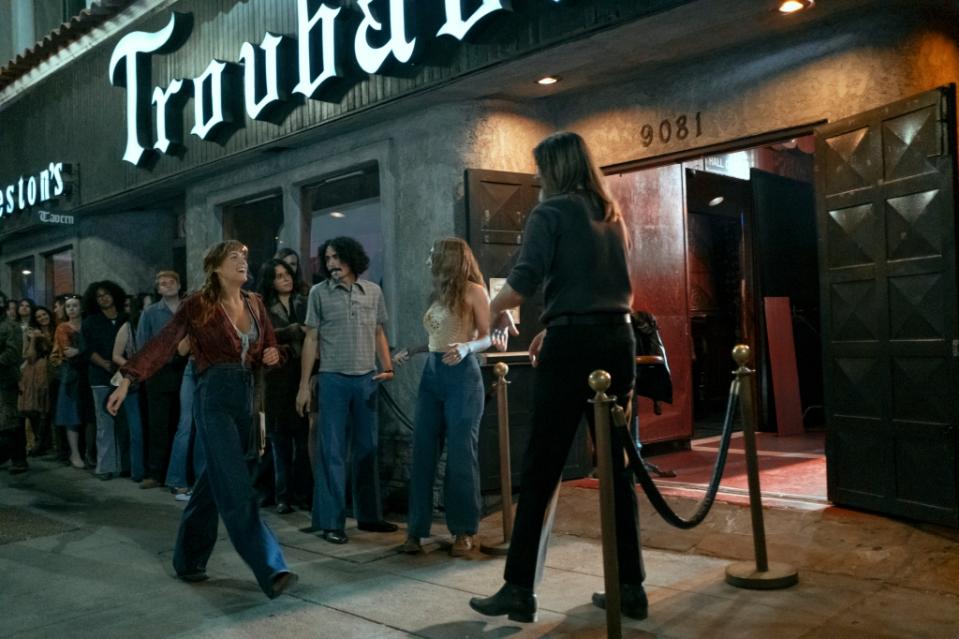
The Troubadour
The Troubadour on Santa Monica Blvd. was the place to hear folk music throughout the ’60s, so it was perfectly positioned, both geographically and musically, for the arrival of the Laurel Canyon-based musicians. Elton John famously got his first major attention there, Buffalo Springfield played its first gig there back in 1966, and Bruce Springsteen opened for the Byrds’ Roger McGuinn in 1974. Still going strong, The Troub has always been the kinder, gentler alternative to the clubs of the Sunset Strip, and the absolutely perfect place for the romantic country rock of Daisy Jones to flourish.
“The great thing is Troub’s front bar for the most part is really untouched, in perfect shape from the ’70s,” Kender says.
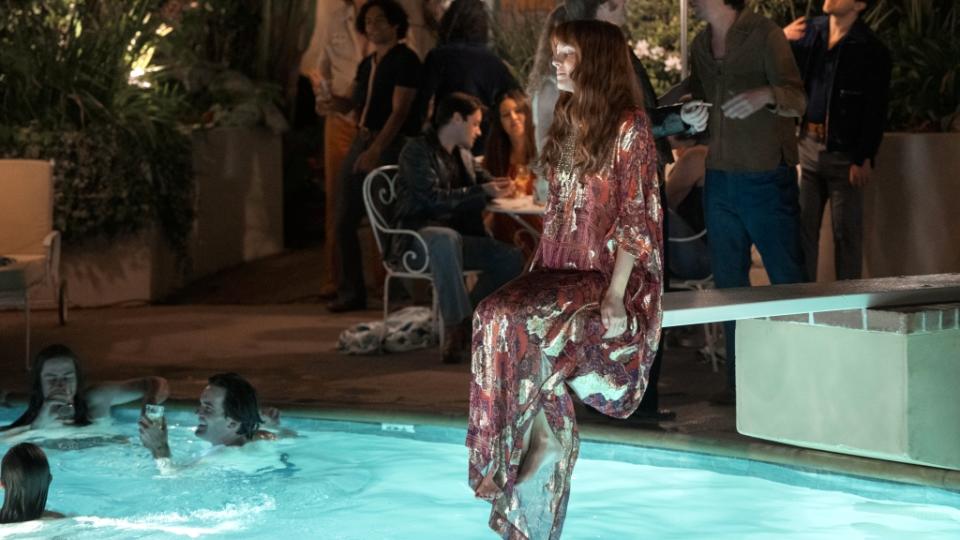
Chateau Marmont
In the grand tradition of dissolute musicians and actors, when Daisy doesn’t know quite what to do with herself, she moves into the Chateau Marmont. Like New York’s Hotel Chelsea, the Chateau Marmont, which opened in 1929, often served as a longterm residence for those in-between other living situations, as well as a spot for visiting royalty like Led Zeppelin. In between Jim Morrison and John Belushi…well, apparently there was Daisy Jones, swanning around the pool and beginning her descent into decadence.
Because the Chateau was having union problems, “Daisy Jones” ended up shooting at the Courtney Villas in Nichols Canyon, a 1920s condo complex with a pool that, although it was a different shape than the Chateau’s, still creates the right old Hollywood feeling. “The only thing that was missing was a diving board,” Kender remembers. Since no major alterations were allowed to the historic property, the art department ended up attaching a steel plate to a small pool ladder so Keough could stand on it in a pivotal scene.
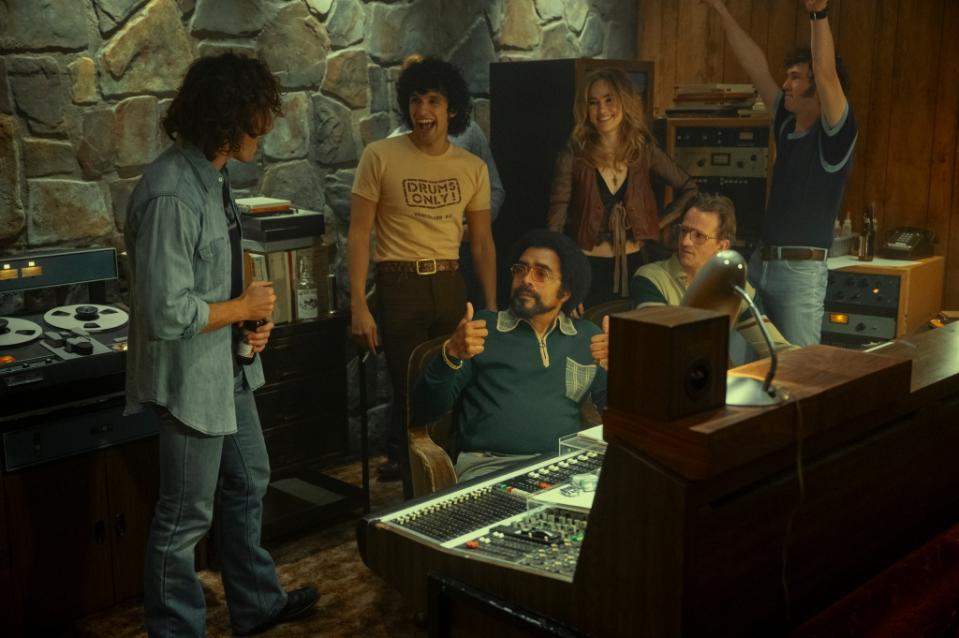
Sound City Studios
Daisy Jones & the Six record their album at Sound City Studios in L.A.’s San Fernando Valley. Tucked away in an industrial neighborhood, it very appropriately kicked off its history with Lindsey Buckingham and Stevie Nicks performing the first song on the console, which led to their being invited to join Fleetwood Mac. Charles Manson recorded there; Neil Young recorded “After the Gold Rush”; Tom Petty & the Heartbreakers, the Red Hot Chili Peppers and Nirvana were among the hundreds of other acts who captured the “Sound City” sound. The main studio remains exactly the same, down to its worn linoleum and original board, though Dave Grohl has acquired one of the historic recording consoles.
“We went into Sound City and built the lobby set within the lobby,” Kender says. “One of my favorite finds is there was a great picture of Stevie Nicks recording in their big studio, and on the wall was this incredible vintage fabric. We pulled the burlap back, and that vintage fabric was underneath!”
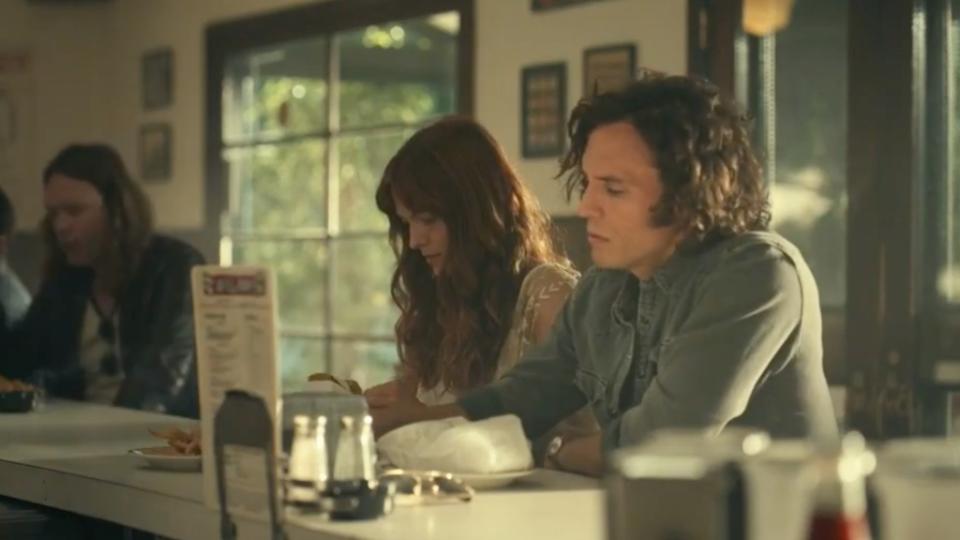
The Apple Pan
You have to give Daisy some credit for self-soothing with not just one but two of L.A.’s most classic sandwiches, the Hickory Burger from the Apple Pan in West L.A. Open since 1947, the Apple Pan still looks much the same as it has for 76 years with its horseshoe-shaped counter and servers sporting white paper caps. Daisy may have skipped the pie; don’t make the same mistake.
The Riot House/ Sunset Hyatt/ Andaz
Opened in 1963 as the Continental Hyatt House, the Sunset Strip hotel was nicknamed “The Riot House” or the Riot Hyatt. Bands such as Led Zeppelin, the Who and Rolling Stones often stayed there on tour, and both Keith Richards and Keith Moon were said to have dropped TVs from the balconies. The hotel also went back to the ’70s for Cameron Crowe’s “Almost Famous.”
Kender says the crew had a quick turnaround to remove the desert-scaping plants that are currently trendy and return the rooftop pool to its Riot Hyatt days.
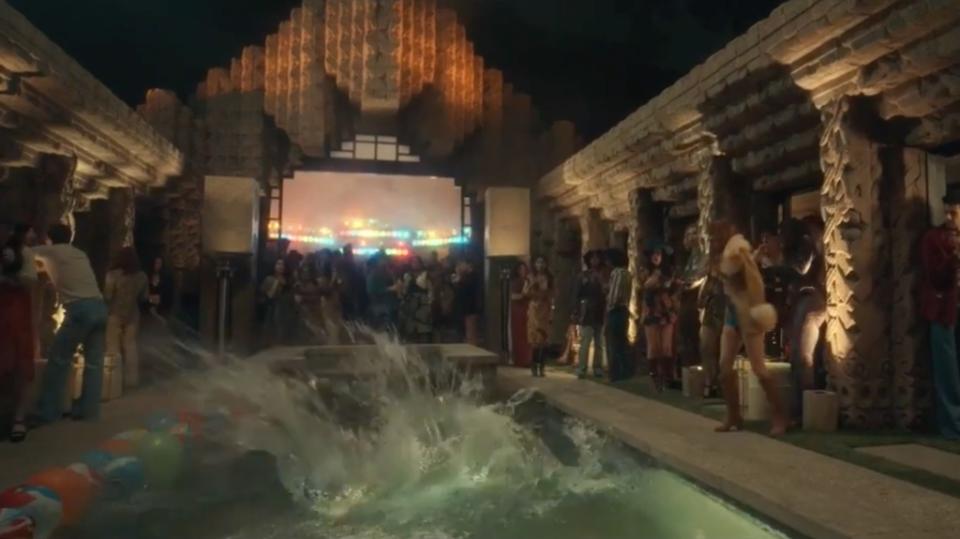
The John Sowden House
Also known at the “Jaws House” for its dramatic facade of textile blocks, this Franklin Ave. house designed by Frank Lloyd Wright’s son Lloyd Wright in 1926 makes the perfect backdrop for a decadent Hollywood rock ‘n roll party. Reminiscent of a Mayan temple, the courtyard design enables sightlines to pretty much every room in the house from every other room, which is very helpful when checking out the other party guests. It’s not clear who lived there in the 1970s, but there was definitely no pool in the middle of the courtyard at the time.
When shooting the party where Simone meets Bernie for the first time, Kender was excited to showcase the house despite worries it was too over-the-top. “This show is a little bit of a love letter to L.A.,” she says, “and this is a part of L.A.”
Best of Variety
Final Oscars Predictions: Animated Short - Will the Academy Go for 'The Boy' or 'Dicks?'
Final Oscar Predictions: Documentary Short - Will the Academy Go for Malala or 'Elephants?'
Sign up for Variety’s Newsletter. For the latest news, follow us on Facebook, Twitter, and Instagram.

